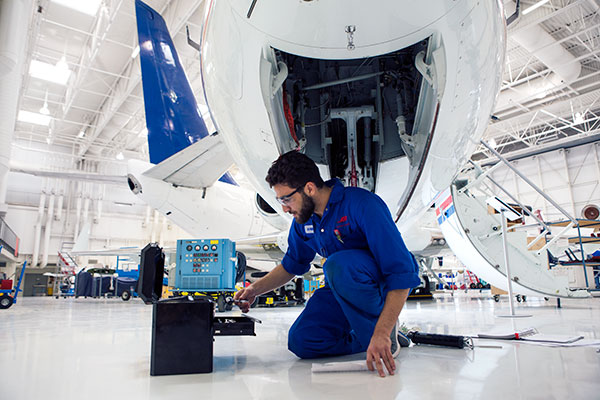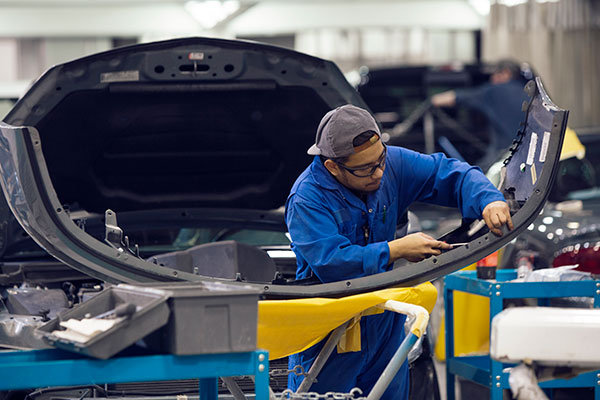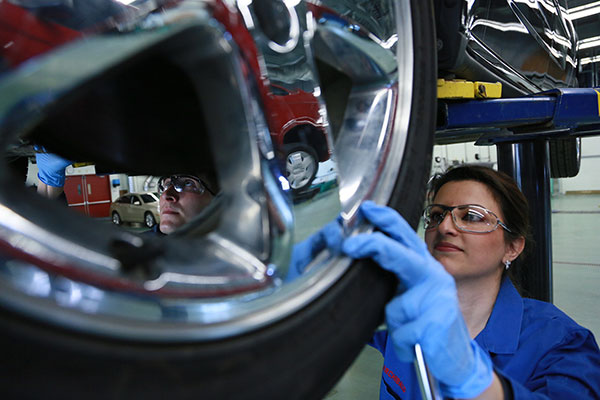On this page:
Overview
If you're passionate about cars and want to build a rewarding career in the automotive industry, this two-year diploma program will set you up for success.
With guidance from our industry-experienced instructors, you will:
- learn automotive vehicle maintenance, diagnosis and repairs
- study manufacturer specifications
- gain customer service and communication skills
- work on actual cars and gain real-world experience.
Once you graduate, you'll have various career options, including working as an apprentice or service advisor in a general or specialty automotive shop.
Many of our graduates choose to continue their training through an apprenticeship. Graduates are eligible to challenge the Alberta Apprenticeship and Industry Training (AIT) Automotive Service Technician periods one through four exams, a big step towards becoming a journeyperson certified automotive service technician.
As a journeyperson technician, you can specialize in engines, driveability, electrical systems, chassis systems, wheel alignment and automatic transmissions. You'll also have the potential to advance beyond mechanics into management positions like shop foreman or service manager.
With a high demand for automotive service technicians, you'll have a great chance of finding a job in the trade.
Automotive service technicians tend to be objective, innovative and methodical.
You need:
- an Alberta driver's license
- good hearing, eyesight and manual dexterity
- mechanical aptitude and interest
- a working knowledge of electricity, electronics and computers
- customer service skills.
You should enjoy performing tasks that require precision, working with your hands and working independently.
This program aligns with the Alberta Apprenticeship and Industry Training (AIT) curriculum for Automotive Service Technicians, periods one through four.
Graduates are eligible to challenge the technical training exams.
Upon passing, you can register as an apprentice and complete the on-the-job training hours to earn your journeyperson designation. Graduates are eligible to receive a 156-hour, on-the-job training credit towards each of the four periods of the Automotive Service Technician apprenticeship.
In the second year of this program, you'll participate in a capstone project where you'll work in teams to complete research, collect and analyze data and produce a project proposal.
Your team will then execute your proposal, develop progress reports, and a final report and present your outcomes and findings.
Upon successfully completing this program, you'll be awarded a SAIT Automotive Service Technology diploma.
Careers and opportunities
Each year, SAIT conducts a survey between February and April to determine the employment rate, salary and satisfaction of our newest SAIT alumni.
![]() 96% graduate employment rate
96% graduate employment rate
![]() $40,000 average starting salary
$40,000 average starting salary
Find out more about our graduate employment statistics >
Our graduates may work in the following occupations. Some careers require additional experience and education.
Associated National Occupational Classification (NOC) codes: 72020, 72410, 72411, 72422, 72423, 74203.

Career planning support
Unsure which career path is for you? Here are some recommended career planning resources to help you decide your future.
You can also head to Alberta alis for lots of information about careers in Alberta, including quizzes and labour market information to help you narrow down a path.
Finally, you can take our online career finder quiz, which can help narrow your options based on your current skills and interests.
Courses
The Automotive Service Technology program requires 60 credits (20 courses) to complete.
The program spans two years, with two semesters each year.
| Course | Credits |
|---|---|
|
In this course the learner will study the following concepts: arithmetic, practical measurement, algebra, trigonometry and mathematical physics. |
1.5 |
|
Learners will gain an understanding of the strategies and skills required for effective communication in a professional environment. Topics include active listening, conflict resolution, writing industry specific reports and documents, developing interview skills, and giving and receiving feedback. |
1.5 |
|
In this course you will explain basic electrical principles and the principles of magnetism. You will perform electrical circuit measurements. You will diagnose and service batteries. You will diagnose and repair simple electrical circuits. You will use industry standard scan tools and software to complete basic operations. |
1.5 |
|
Building on the basic electrical principles you've already learned, this course teaches you more advanced electrical terms, concepts, and formulas. You'll learn how to determine electrical values in a circuit and you'll study the operation of a charging system and a starter motor. In addition, you'll learn how to diagnose electrical systems, charging systems and starting systems. Pre-requisites:
|
3 |
|
In this course you will use electrical diagnostic aids and test procedures. You will describe and test input and output devices. You will describe the operation of automotive control modules and of vehicle networks. You will interpret wiring diagrams and related information to evaluate advanced circuit operation. Pre-requisites:
|
3 |
|
As the automotive industry undergoes a transformative shift towards sustainable transportation, the demand for skilled professionals capable of servicing electric vehicles (EVs) is rapidly increasing. This comprehensive course is designed to equip learners with the knowledge and practical skills required to excel in the field of hybrid and electric vehicle service, repair, and maintenance. Topics covered include high voltage safety procedures, high voltage vehicles, electric motors, battery systems, inverters and control systems, charging systems, HVAC systems specific to high voltage vehicles and autonomous vehicles. Pre-requisites:
|
3 |
|
This course introduces you to the fundamental mathematical principles that you will need to meet the requirements of your program. You'll explore the trade applications of whole numbers, fractions and decimals, as well as metric and imperial conversion and geometric problems. You'll perform algebraic operations and use ratios, proportions and percentages to solve trade-related problems. |
1.5 |
|
This course familiarizes you with industry standards and best practices, as well as common materials, tools and procedures in the automotive service trade. You will learn to apply legislation and regulations that ensure safety, including using industry standard practices for climbing, lifting and hoisting, fire protection and working with hazardous materials. You will learn about common specialty hand tools and electronic service information. You will also learn to communicate using industry standard terms and units for parts and operation, measure components using common tools, and assemble components using common fasteners, adhesives and sealers. |
1.5 |
|
In this course, you will analyze the design and operating principles of frames, suspension systems and steering systems. You will diagnose and repair mechanical problems related to electrically- and hydraulically-assisted steering gears. This course will also cover drive shafts and steering columns, providing opportunities for hands-on learning as you perform alignment procedures, service drive shaft assemblies, and diagnose problems with steering-related safety devices. |
6 |
|
In this course you will describe brake system principles and operation. You will diagnose and repair: brake system hydraulic components; drum brake systems; disc brake systems; and power brakes. You will diagnose and service brake systems. |
3 |
|
In this course you will learn about basic maintenance routines for vehicles as well as service procedures for light utility trailers. In addition, you will learn how to weld using oxyacetylene equipment. |
1.5 |
|
In this course, you'll learn about the following topics: the operation of internal combustion engines; crankshaft and friction bearing function, design and construction; the function of pistons and related components; camshaft and valve train operation; and the operation and function of cylinder head assemblies. As you gain knowledge of how various systems work, you'll practice servicing and repairing them. You'll disassemble and reassemble engines and attached components. You'll determine the serviceability of an engine block as well as inspect and measure a crankshaft, friction bearings and related components, pistons and related components, and cylinder heads and related components. You'll diagnose camshafts and valve train components, as well as engine mechanical problems. In addition, you'll diagnose and repair air induction systems and related components, exhaust systems, lubricating systems, as well as cooling systems and related components. |
6 |
|
In this course, students explore the operating principles and construction of manual transmissions, transaxles and clutch systems. They will trace the path of power through various gear ranges, calculate gear ratios, and examine lubrication requirements, synchromesh units, shift mechanisms, bearings and seals. Through hands-on practice, students will disassemble, reassemble and adjust manual transmissions and transaxles, as well as diagnose related issues. Additionally, students will study clutch operation and maintenance procedures, gaining essential skills to effectively troubleshoot and service these systems. |
1.5 |
|
In this course you will learn to diagnose manual, electronic and all wheel drive (AWD) transfer cases, as well as four wheel drive (4WD) engagement controls. You will gain an understanding of the basic components and operation of these systems, as well as the common problems associated with each. In addition, you'll get hands-on experience with assembling and assessing components of transfer cases. |
1.5 |
|
In this course you will learn to diagnose and repair drive axle assembles, including servicing axle shafts and bearings, understanding the operation of differentials and final drive gear sets, and assembling a final drive gear set. In addition, you will learn to diagnose common drive axle issues, perform various diagnostic tests and service as well as repair drive axle, differential case and drive pinion gear bearings and seals. |
1.5 |
|
In this course you will describe the operation of an ignition system and of electronic ignition systems. You will diagnose ignition systems. |
3 |
|
In this course you will explain fuel properties and handling practices. You will describe: the combustion process and resulting emissions; the operation of fuel injection systems; and the operation of alternate fuel (compressed gas) systems. You will diagnose and repair fuel tanks and supply systems, as well as fuel injection systems. |
3 |
|
In this course you will diagnose and repair: exhaust gas recirculation systems; air injection systems; catalytic converter systems; and evaporative emission control systems. |
1.5 |
|
In this course you will diagnose and repair: instrument panel circuits and warning systems; vehicle lighting systems; wiper and washer systems; power accessories; heated systems; vehicle speed control systems; vehicle networks; and occupant restraint systems. You will diagnose: information and entertainment systems; factory installed vehicle safety and security systems; and problems related to anti-lock brake systems. |
3 |
|
In this course you will diagnose: planetary gear sets; torque converters; problems related to the circuits in an electronically-controlled automatic transmission; and problems related to electronically-controlled automatic transmission operation. You will describe operating principles of an automatic transmission. You will explain the operation of electronically-controlled automatic transmissions and the operation of CVTs. You will diagnose and repair: oil pumps; clutches, bands and servos; hydraulic valves; and shift valves. You will test an automatic transmission and repair automatic transmissions. |
6 |
|
In this course you will diagnose and repair electronically-controlled diesel fuel injection systems. You will describe diesel engine emission controls. |
1.5 |
|
In this course you will explain the operation of HVAC systems. You will diagnose HVAC controls. You will diagnose and repair HVAC systems. |
1.5 |
|
In this course you will diagnose problems associated with integrated vehicle systems. |
1.5 |
|
In this course you will use coaching skills when training an apprentice, and use Red Seal products to prepare for an inter-provincial examination. |
1.5 |
Progression
You must attain a PGPA and/or a CGPA of 2.0 or better each semester and pass the prerequisite courses to progress through the program.
To qualify for graduation, you must pass all courses, attain a CGPA of 2.0 or better and complete course requirements within the prescribed timelines.
Review our grading and progression procedure >

Explore your options!
Some courses in this program are available through Open Studies. You can complete courses via Open Studies to get a head start on your education, reduce your course load once accepted into a credentialed program, or determine which career path best suits you before you fully commit.
You may also take courses for general interest or personal and professional development.
Admission requirements
Applicants educated in Canada
Applicants must demonstrate English language proficiency and completion of the following courses or equivalents:
- at least 50% in Math 20-1 or 20-2 or 20-3, and
- at least 50% in English Language Arts 30-1 or 30-2, and
- at least 50% in a Grade 11 science.
SAIT accepts high school course equivalents for admission for applicants educated outside Alberta.
All applicants who were educated outside of Canada must demonstrate English language proficiency and provide proof they meet the program admission requirements outlined above with an international document assessment. Find accepted educational documents and assessment options.
SAIT may also accept courses completed at certain international post-secondary institutions.

Academic Upgrading
Missing an admission requirement for this program? Upgrade your prior education to help you receive admission into one of SAIT's career programs.

English language proficiency
All applicants must demonstrate English language proficiency prior to admission, including students educated in Canada.
Transfer agreements
At SAIT, we evaluate post-secondary credit you have previously earned and apply it to your SAIT credential. Explore our formal transfer agreements available for this program.
We can evaluate your prior education, even if we don't have a formal agreement in place.
Submit a transfer credit application
There are no formal transfer agreements currently in place for this program.
Transfer options for graduates
Build on the knowledge you’ve learned at SAIT. The opportunity to advance your education at an accredited post-secondary institution may be available.
🔗 Visit Transfer Alberta search tool for all transfer agreements in Alberta (including UCalgary, MRU and BVC).
If there are transfer agreements with other institutions outside of Alberta, nationally or internationally, they will be listed below.
Available intakes
Spring 2025
Start dates:
- Domestic students: Closed
-
-
Application deadline:
-
- International students: Closed
-
-
Application deadline:
-
Fall 2025
Start dates:
- Domestic students: Closed
-
-
Application deadline:
-
- International students: Open
-
-
Application deadline: May 29, 2025
-
Costs
2025/26 tuition and fees
The following costs are effective as of July 1, 2025.
The estimated total cost of tuition and fees is based on the suggested schedule of study. Following a modified schedule will impact the fees you pay per semester and may alter final costs.
Domestic students
The program total is based on the estimated amount you will pay if you enter this program during the 2025/26 academic year. The program total amount listed on your letter of admission may appear higher. This amount is your maximum tuition guarantee for the program. SAIT will not exceed this maximum, regardless of changes in tuition and fees between academic years.
Books and supplies are approximately $450 per full-time year.
This is a bring-your-own-device program with a standard computer hardware and software requirement. See the specific requirements on our computers and laptops page.
Find your booklist on the SAIT Bookstore's website. The booklist will be available closer to the program start date. Can't find your program or course? The bookstore didn't receive a textbook list. Contact your program directly to determine if they're still refining course details or if you're in luck; no textbook purchase is required this term.
Required personal protective equipment (PPE)
The industry-approved PPE you'll need will be discussed during your first few days of classes.
You will need:
- CSA-approved steel-toe boots and safety glasses
- welding gloves
- earplugs (supplied)
- coveralls.
Service technician coveralls will be available for purchase at the start of the semester. Tools will be provided.
Required equipment/tools
Tools will be provided throughout your program.
A driver's license and the ability to maneuver a vehicle in tight spaces and drive a manual transmission vehicle are highly recommended to succeed in this program and industry.
2023/24 tuition and fees
The following costs are effective until June 30, 2024.
Domestic students

Financial aid
Paying for your education may feel overwhelming, but we have resources and programs that can help, including information about payment options, student loans, grants and scholarships.
Application process
Ready to apply?
Follow our step-by-step guide to submitting a successful application.
Communication during admission
Email is the primary source of communication during the selection process. Ensure your personal email account is managed appropriately to receive our emails, files and communications. We recommend you add the transportation.info@sait.ca domain to your safe senders list or you risk missing critical email messages.

Begin your application
Apply now using the online application portal.
Ensure you have a valid Visa or Mastercard to pay the non-refundable application fee of $120 for domestic applicants or $175 for international applicants.
Information sessions
Prepare for a strong start in your chosen program or get the details you need to decide your future path.
Our expert staff and faculty are ready to answer your questions and provide information about the following:
- What sets SAIT apart
- An introduction to the program and area of study
- Admission requirements
- Future career paths
- Information on the earning potential and graduate employment rates.
Contact us
School of Transportation Advising
-
Phone - 403.284.8471
International Student Advising
-
Phone - 403.284.8852
-
Email - international@sait.ca
Subscribe for updates
Your journey starts here! Sign up to get important updates on:
- Transportation and logistics programs
- Application information
- Relevant news and events

Oki, Âba wathtech, Danit'ada, Tawnshi, Hello.
SAIT is located on the traditional territories of the Niitsitapi (Blackfoot) and the people of Treaty 7 which includes the Siksika, the Piikani, the Kainai, the Tsuut’ina and the Îyârhe Nakoda of Bearspaw, Chiniki and Goodstoney.
We are situated in an area the Blackfoot tribes traditionally called Moh’kinsstis, where the Bow River meets the Elbow River. We now call it the city of Calgary, which is also home to the Métis Nation of Alberta.




